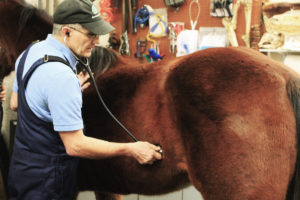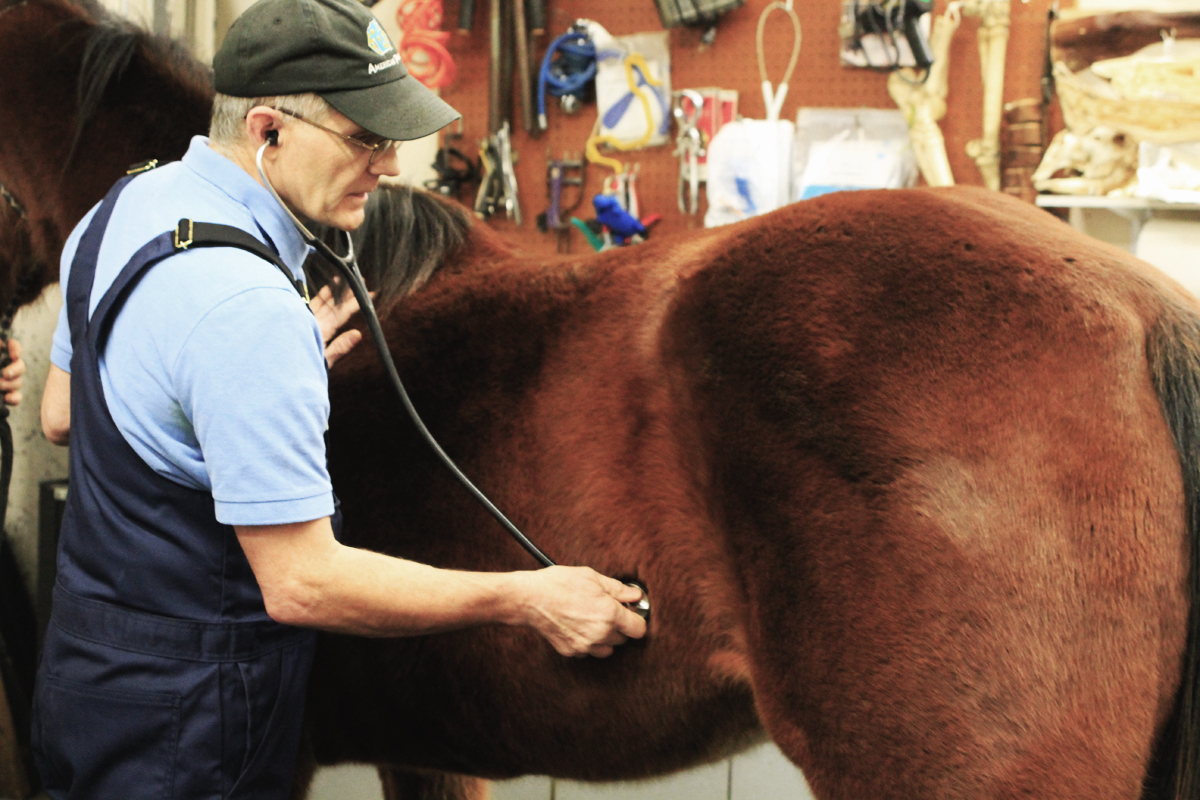Part 2: Causes, Management, and Prevention
by Dave Sauter, DVM

This two part series is a review of the Frank Milne State of the Art lecture presented by Dr. Stephanie Valberg at the 58th annual American Association of Equine Practitioners convention held in Anaheim, California this past December. Part One covered Dr. Valberg’s review of the history of tying-up, our understanding of the disease, and how recent scientific advances have expanded our knowledge and treatment of it. We learned that tying-up is not simply one problem, but rather a symptom of several different problems and types of tying up. She discussed the following:
PSSM
Polysaccharide Storage Myopathy (PSSM) was first recognized as a specific muscle disease of Quarter Horse related breeds in 1992. It is a disease resulting in abnormal energy storage (i.e. abnormal glycogen) and energy utilization in muscle. There are two subtypes of PSSM:
PSSM1
Glucose is one of the “fuels” muscle use to provide the energy to contract and relax. In order to provide a ready reserve of energy that can be rapidly mobilized when needed, normal muscle cells link huge numbers of glucose molecules together, forming a polysaccharide energy storehouse called glycogen. The enzyme that enables this glycogen production is called glycogen synthase 1. When muscle cells need energy, the glycogen production pathway switches off and the glycogen burning pathway switches on. Horses with PSSM1 have a genetic defect resulting in defective glycogen synthase 1. The defective gene causes the enzyme to be overactive, resulting in overproduction of abnormal glycogen. Also, the defective enzyme fails to switch off when exercise begins. These unfortunate muscle cells keep producing glycogen when they need to be burning it. Even though there is plenty of stored energy in these cells, it is unavailable since the “burning” pathway fails to switch on. The cell is quickly depleted of any available glucose that is not already tied up in glycogen. Continued work by energy depleted muscle results in damage to the muscle. With enough muscle damage, symptoms of tying-up emerge.
One of the functions of insulin is to move glucose into cells. PSSM horses are more sensitive to insulin, resulting in even more glucose entering muscle cells. This compounds the problem of glycogen overproduction and eventual energy depletion. Starch and sugar in the diet stimulates greater insulin release, increasing the risk of tying-up and sore muscles. PSSM1 is found in 6% to 10% of all Quarter Horses and Paints, but in 28% of the subgroup of Quarter Horses bred for halter. It is nearly nonexistent in Arabians, Standardbreds and Thoroughbreds.
Whether PSSM horses have episodes of tying-up or not depends on several factors, such as diet and exercise. Periods of rest prior to exercise and diets high in starch and sugar are triggering factors. The type of exercise is another factor. Light exercise is heavily dependent on glycogen and therefore more likely to generate problems (heavy exercise results in quicker transition into use of alternatives to glucose for energy). For example, 20 minutes of walk and trot with frequent transitions. Signs of an sudden, acute episode include tucking up in the abdomen, trembling of muscles, muscle stiffness, sweating, reluctance to move forward, gait abnormalities, discolored urine, and sometimes colic. Symptoms of chronic cases can be less dramatic and include lack of energy, reluctance to move forward, a “sour” attitude, poor performance, and chronic back pain. Sometimes the horse might stop and stretch, as if to urinate. Other horses, especially drafts, tend to have subtle symptoms that might go undetected. Tying-up can be diagnosed by blood tests, comparing baseline muscle enzyme levels prior to 15 minutes of exercise at a walk and trot with lots of transitions, to levels four hours later. There is a genetic test that can detect the defective gene that causes PSSM1.
PSSM2
These horses have similar symptoms to PSSM1 horse but do not have the abnormal gene for glycogen synthase. In these horses, the root cause of the overproduction of glycogen and energy depletion has not been discovered yet. Diagnosis is based on muscle biopsy results demonstrating abnormal glycogen and the genetic test demonstrating an absence of the defective gene of PSSM1. Of the QH’s with PSSM, only about 28% are type 2, whereas of the Warmbloods with PSSM, about 80% are type 2. The QH’s with this type tend to be more of the performance type, such as barrels, cutting and reining. The cause for this type is unknown.
Horse with PSSM will always have an underlying tendency for muscle soreness. Confinement and rest tend to cause more problems with these horses. Instead, turn-out with other horses is a key element to prevention. Duration and frequency of exercise appears to be more important than the intensity of exercise. Gradual changes in exercise, consistency and regularity are very important. Minimize days without exercise; even 10 or 15 minutes on “off” days can be very beneficial. Fitness is the best prevention.
For diet, keep Non-Structural Carbohydrate (NSCs include starch & sugar) low so there is less glucose and insulin available. Fat provides an alternate energy source and is beneficial for PSSM horses. For average weight PSSM horses, limit NSC to 12% fed at 1.5% of body weight and increase fat levels to 13% or higher of total digestible energy in the diet. Extra vitamin E supplementation (1000 or more international units per day) is recommended for horses on high fat diets. Be careful with overweight horses since obesity leads to other problems. In order to get more fat into an easy keeper’s diet, starch and sugar will have to be restricted even more, restricting NSC to 5-10%. Another strategy, rather than feeding more fat, to manage the overweight PSSM horse is to fast them for 6-8 hours prior to exercise. Fasting results in lower blood glucose and insulin levels and levels of circulating fatty acids in the blood, providing an alternate energy source. Dr. Valberg emphasized that the dietary changes will not work unless the exercise program is also implemented.
RER
Recurrent Exertional Rhabdomyolysis (RER) is the type of tying-up associated more with racehorses and is found more in Thoroughbreds and Standardbreds, although there are some cases in Arabians and Warmbloods. The disorder differs from PSSM in that there is not abnormal glycogen and abnormal energy utilization, but rather an abnormal regulation of muscle contraction and relaxation. RER is not caused by lactic acidosis. The exact mechanism has not yet been determined. Episodes of tying-up are recurring, often associated with excitement in an already nervous individual. It is triggered suddenly during exercise.
Management of RER has similarities to that for PSSM. Regular exercise is important. Low starch and high fat diets are also helpful for RER horses, but for different reasons. This stems from the lower blood sugar, lower insulin and lower cortisol levels which all contribute to a milder, calmer demeanor.
Sporadic Tying-up
Unlike the examples above, sporadic tying-up is not caused by some internal fault in the individual horse’s genetics or makeup. Rather is it the result of some external cause (or recurring external cause) and can happen to a horse of any age, breed or discipline. Here are three examples of external causes: focal or generalized muscle damage such as from a muscle strain or getting cast and struggling to get up; exercise beyond the level of fitness or to the point of exhaustion (polo horses and endurance horses); extreme dietary imbalances – diets very high in starch but low in fiber and diets low in vitamin E and selenium.
Dr. Valberg’s passion and expertise researching tying-up and neuromuscular disorders in horses has greatly advanced our current understanding and is reaping practical benefits for suffering horses.
Published March 2013 Issue

Dave Sauter is a Minnesota native and graduated from the University of Minnesota in 1987. Following graduation he interned at Rood and Riddle Equine Hospital in Lexington, Kentucky. After this internship, he continued to work exclusively with horses for another five years in Kentucky before moving out West and joining Kulshan Veterinary Hospital in Lynden, WA. He is a member of the AAEP, AVMA and the WSVMA. For more information about Kulshan Veterinary Hospital call 360-354-5095 or email [email protected]. www.KulshanVet.com






